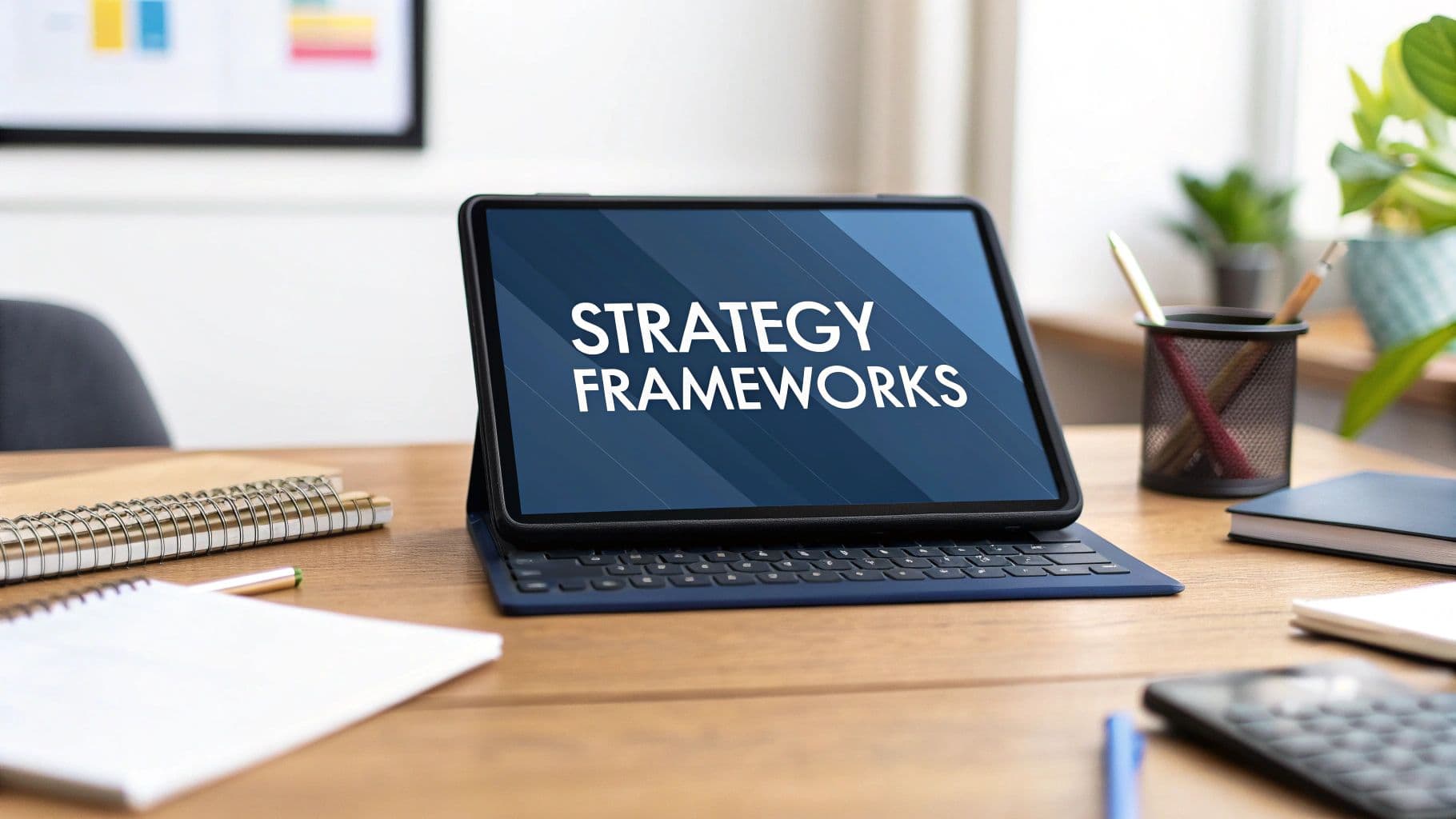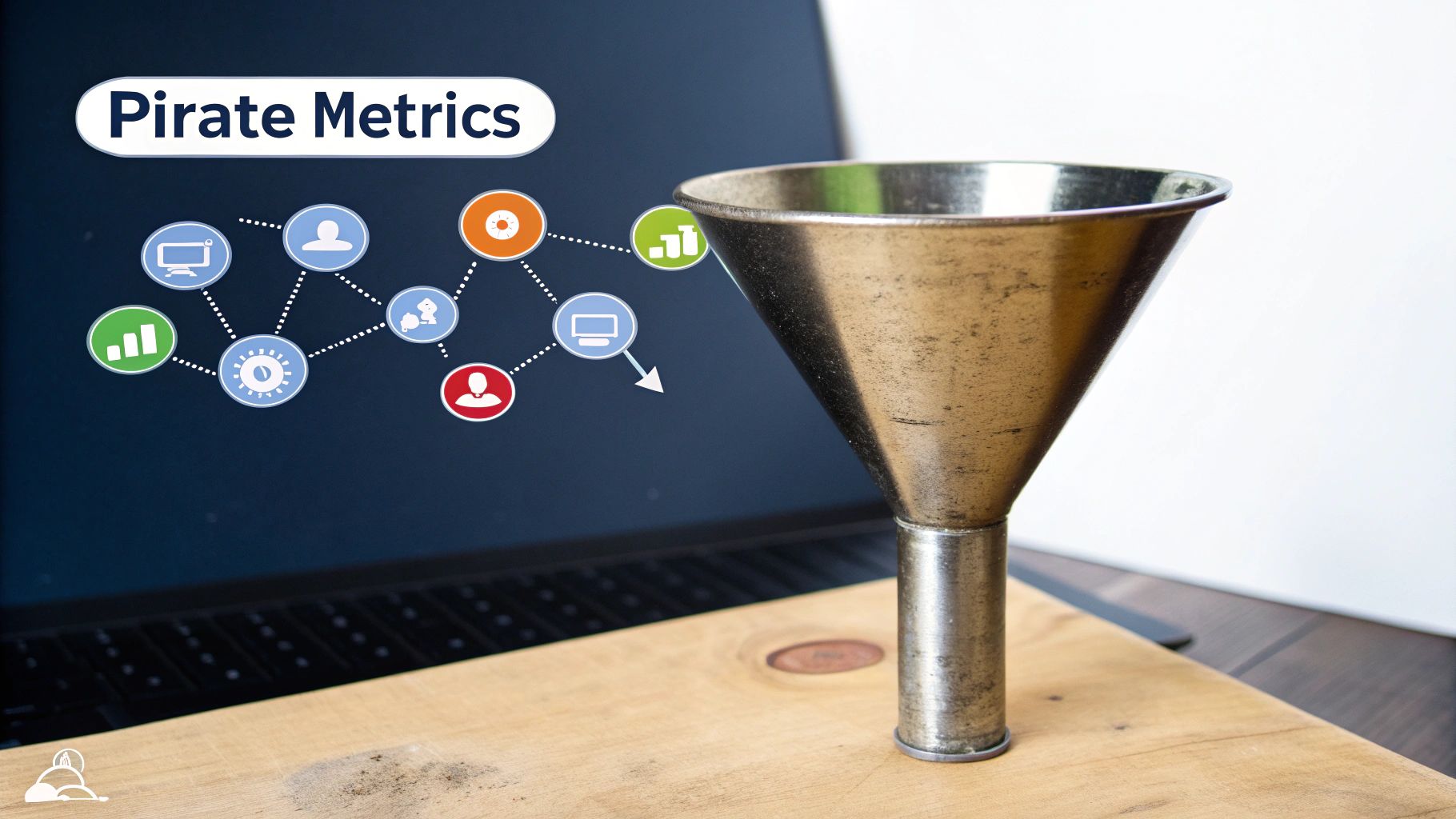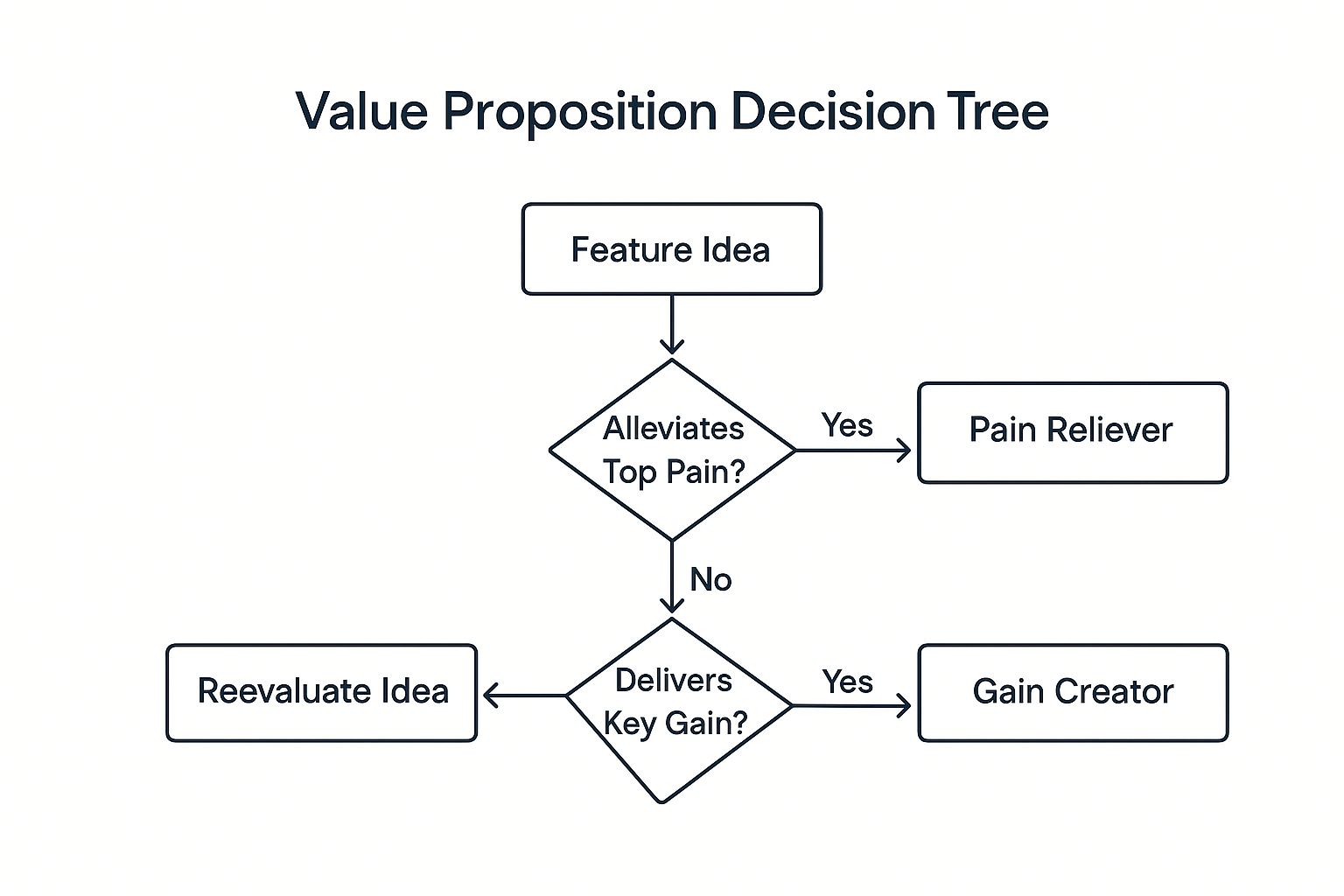10 Essential Product Strategy Frameworks for 2025
Discover 10 powerful product strategy frameworks to build better products. Learn how to apply JTBD, OKRs, Blue Ocean, and more with our expert guide.

Building a successful product isn't just about a great idea; it's about navigating the complex path from concept to market leader. This requires more than intuition, it demands a structured approach. A clear vision sets the destination, but product strategy frameworks are the proven blueprints that transform ambitious goals into actionable plans, ensuring every feature, marketing dollar, and development sprint pushes you in the right direction. While a vision is crucial, a detailed roadmap translates that vision into actionable steps; for a deeper dive into building and managing this strategic document, consult our ultimate guide to creating a product roadmap.
These frameworks provide the critical structure needed to answer fundamental questions: Are we solving the right problem? Who are our real customers? Where can we find uncontested market space? Without them, teams often work in silos, features miss the mark, and valuable resources are wasted on guesswork.
This guide moves beyond theory, breaking down 10 essential product strategy frameworks into practical, actionable steps. Whether you're a startup searching for product-market fit or an enterprise looking to innovate, mastering these models will equip you to make smarter decisions, align your teams, and build products that don't just launch, but win.
1. Jobs to be Done (JTBD)
The Jobs to be Done (JTBD) theory shifts your focus from product features to customer outcomes. It posits that customers don't buy products; they "hire" them to do a "job." This framework forces teams to dig deeper than surface-level demographics or personas to understand the real-world progress a customer is trying to make.

Popularized by Clayton Christensen, JTBD helps uncover the functional, social, and emotional drivers behind a purchase. For example, McDonald's famously discovered commuters hired milkshakes for a long, boring drive, not just as a sweet treat. This insight led them to make the milkshake thicker and the purchasing process faster, perfectly addressing the real job. This approach is one of the most insightful product strategy frameworks for achieving genuine market fit.
When to Use JTBD
This framework is ideal when you need to understand the causality behind customer choice. Use it to innovate in a crowded market, identify new growth opportunities, or improve an existing product's value proposition by aligning it more closely with the customer's core needs.
How to Implement It
- Conduct "Switch" Interviews: Talk to customers who recently switched to or from your product. Focus on the timeline of their decision, not just their opinion of your product.
- Identify Compensating Behaviors: Look for makeshift solutions or workarounds customers use. These often reveal an unmet "job."
- Frame the Job Story: Define the job using this format: "When [situation], I want to [motivation], so I can [expected outcome]."
- Validate Quantitatively: After identifying potential jobs through qualitative research, use surveys to validate how widespread and important these jobs are among your target audience.
By focusing on the "why" behind the buy, JTBD provides a stable, long-term target for innovation. For a deeper dive, explore this guide and a free Jobs to be Done template to start applying this powerful framework.
2. Product-Market Fit Framework
Product-Market Fit (PMF) is the degree to which a product satisfies strong market demand. This framework centers on validating that you've built something a specific market segment truly wants and is willing to pay for. It is less a step-by-step process and more a state of being that product teams must rigorously measure and achieve.
Coined by Marc Andreessen, PMF is about "being in a good market with a product that can satisfy that market." Companies like Slack achieved it when their organic growth and high retention rates signaled they had solved a major pain point. To successfully leverage this framework, it's essential to have a clear grasp of understanding what product market fit means for your startup.
When to Use PMF
This framework is critical in the early stages of a product's lifecycle, before scaling sales and marketing efforts. It's also vital when entering a new market or pivoting an existing product. Use it to ensure you are building on a solid foundation of genuine customer need rather than assumptions.
How to Implement It
- Survey Users: Use the Sean Ellis test by asking users, "How would you feel if you could no longer use this product?" If over 40% answer "very disappointed," you have a strong signal of PMF.
- Track Leading Indicators: Monitor key metrics like user retention, engagement frequency, and organic growth rates. A high viral coefficient is a powerful sign.
- Identify Your Champions: Find your most enthusiastic users and conduct deep interviews to understand why they value your product so much.
- Segment Your Audience: If you don't have PMF across your entire user base, analyze segments to see if you have it within a specific niche.
Achieving PMF is a core goal for any product, making this one of the most fundamental product strategy frameworks. Learn more about how to measure product-market fit to apply these concepts effectively.
3. Blue Ocean Strategy
Blue Ocean Strategy challenges you to make the competition irrelevant by creating uncontested market space. Instead of fighting for share in a bloody "red ocean" of rivals, this framework guides you to unlock new demand in a clear "blue ocean." It centers on the simultaneous pursuit of differentiation and low cost, a concept known as value innovation.
Pioneered by W. Chan Kim and Renée Mauborgne, this approach is famously illustrated by Cirque du Soleil. By eliminating costly circus elements like animals and star performers while raising artistic and theatrical value, it created a new market that was neither traditional circus nor theater. This is one of the most transformative product strategy frameworks for redefining industry boundaries.
When to Use Blue Ocean Strategy
This framework is most powerful when your market is saturated, growth is stagnating, and competing feels like a zero-sum game. Use it to escape commoditization, create a powerful new value curve, and build a business model with high barriers to imitation.
How to Implement It
- Map Your Strategy Canvas: Visually plot your current market's factors of competition and see where your competitors are investing. This reveals where the red ocean is concentrated.
- Apply the Four Actions Framework: Ask four key questions to reshape your value proposition: What industry factors can you Eliminate? What can you Reduce well below the standard? What should be Raised far above the standard? And what can you Create that the industry has never offered?
- Look Beyond Existing Demand: Shift your focus from existing customers to non-customers. Understand why they don't use your market's current offerings to uncover vast, untapped opportunities.
- Build an End-to-End Model: Ensure your strategy is robust by aligning value, profit, and people propositions. A great value innovation is only sustainable if it's profitable and motivating for your team to execute.
By seeking uncontested space, Blue Ocean Strategy provides a systematic way to render rivals obsolete. To begin charting your course, explore the official Blue Ocean Strategy tools and resources.
4. Lean Product Development
Lean Product Development applies manufacturing principles to product creation, focusing on rapid experimentation, validated learning, and iterative cycles. Popularized by Eric Ries's The Lean Startup, this framework centers on a "Build-Measure-Learn" feedback loop. The goal is to eliminate waste by only building what customers truly value, shortening development time and increasing the odds of market success.
Instead of building a full-featured product based on assumptions, teams build a Minimum Viable Product (MVP). This MVP is used to test the core hypothesis with real users. Dropbox famously started with an explainer video as its MVP to gauge interest before writing a single line of production code. This approach is one of the most effective product strategy frameworks for navigating uncertainty and de-risking new ventures.
When to Use Lean Product Development
This framework is exceptionally powerful for startups or companies entering new markets where uncertainty is high. Use it when you need to validate a core business idea, test a new value proposition, or find product-market fit without investing significant resources upfront. It is also ideal for established companies looking to foster a more innovative, customer-centric culture.
How to Implement It
- Define Riskiest Assumptions: Identify the single biggest assumption that, if proven false, would cause your entire idea to fail. Start by testing that.
- Build a Minimum Viable Product (MVP): Create the smallest possible version of your product that allows you to test your riskiest assumption. This could be a landing page, a video, or a simple prototype.
- Establish Success Metrics: Before launching, define what success looks like. Use clear, quantifiable metrics to measure the outcome of your experiment.
- Pivot or Persevere: Analyze the data and customer feedback from your experiment. Based on this validated learning, decide whether to continue with your current strategy (persevere) or make a significant change in direction (pivot).
5. AARRR Pirate Metrics Framework
The AARRR framework, also known as "Pirate Metrics," breaks the customer lifecycle into five measurable stages: Acquisition, Activation, Retention, Referral, and Revenue. Created by Dave McClure of 500 Startups, this model provides a clear, quantitative lens through which to view and optimize business growth. It shifts focus from vanity metrics to actionable data that directly impacts the customer journey.

This framework helps teams pinpoint the biggest "leaks" in their funnel. For instance, Dropbox famously used a referral program (Referral) that permanently increased signups by 60%, while Facebook focused intensely on the "7 friends in 10 days" metric to ensure new users reached a meaningful "aha!" moment (Activation). As one of the most practical product strategy frameworks, AARRR grounds your efforts in real user behavior.
When to Use AARRR
This framework is essential for growth-focused product teams, startups, and marketers who need to systematically diagnose and optimize their customer funnel. Use it to identify your biggest drop-off points, prioritize product initiatives based on their potential impact on a specific metric, and create a shared language for data-driven decision-making across the company.
How to Implement It
- Define Key Metrics: Assign a specific, measurable metric for each AARRR stage. For Activation, this could be "profile completion" or "first key action taken."
- Identify the Bottleneck: Analyze your data to find the weakest stage. High acquisition but low activation means your first-time user experience needs work.
- Prioritize Retention Early: For new products, focus on Activation and Retention first. Acquiring users for a leaky bucket is a waste of resources.
- Use Cohort Analysis: Track groups of users who signed up in the same period to understand their behavior over time and measure true retention.
- A/B Test Systematically: Formulate hypotheses for improving a stage (e.g., "Changing the onboarding flow will increase Activation by 15%") and run controlled tests.
6. Kano Model
The Kano Model is a product development and customer satisfaction framework that helps teams prioritize features based on how customers will react to their presence or absence. Developed by Professor Noriaki Kano, this model classifies features into categories to guide investment, ensuring resources go toward what truly matters to users. It moves beyond a simple "more is better" approach to functionality.
This model categorizes features into five groups: Must-be, Performance, Excitement (or Delighters), Indifferent, and Reverse. For example, Wi-Fi in a hotel has evolved from an Excitement feature to a Must-be; its absence causes extreme dissatisfaction, but its presence is merely expected. In contrast, Apple’s introduction of Face ID was a true Excitement feature, creating significant differentiation and delight. The Kano Model is one of the most effective product strategy frameworks for balancing baseline expectations with delightful innovation.
When to Use the Kano Model
This framework is most valuable when you have a long list of potential features and need a customer-centric way to prioritize them. Use it to decide between investing in core performance improvements versus innovative new "delighters," or to ensure you aren't neglecting basic expectations that could lead to churn.
How to Implement It
- Conduct Kano Surveys: For each potential feature, ask users two questions: a functional one ("How would you feel if you had this feature?") and a dysfunctional one ("How would you feel if you did not have this feature?").
- Analyze and Categorize: Use the survey responses to classify each feature into one of the five Kano categories.
- Prioritize Strategically: Ensure all Must-be features are present and reliable. Invest in Performance features based on customer value and competitive parity. Select a few Excitement features to create a competitive advantage.
- Re-evaluate Regularly: Customer expectations shift over time. Today’s delighter is tomorrow's basic expectation, so reassess your feature classifications annually.
7. North Star Framework
The North Star Framework focuses the entire company on one critical metric that best captures the core value delivered to customers. This North Star Metric (NSM) acts as a leading indicator of sustainable growth, representing the intersection of customer value and business success. Popularized by growth pioneer Sean Ellis and product analytics company Amplitude, this model prevents teams from working in silos or chasing vanity metrics.

Unlike lagging indicators like revenue, an NSM reflects actual product usage and value creation. For example, Spotify’s NSM is "Time spent listening," which perfectly captures engagement and value. Similarly, Airbnb's "Nights booked" reflects success for both guests and hosts. Using this framework aligns product development with long-term, sustainable growth, making it one of the most powerful product strategy frameworks for achieving company-wide focus.
When to Use the North Star Framework
This framework is most effective when you need to align multiple teams around a single definition of product success. Use it to simplify complex goals, drive proactive growth initiatives, and ensure that daily activities contribute directly to long-term customer value and business results.
How to Implement It
- Choose a Metric that Reflects Customer Value: Your NSM should represent the moment a user experiences your product's core value, not just your company's revenue.
- Ensure it is a Leading Indicator: The NSM must predict future success. An increase in your NSM should reliably lead to an increase in revenue down the line.
- Define Supporting Input Metrics: Identify 3-5 key drivers that your teams can directly influence. For Airbnb's "Nights booked," these might include "Number of listings" and "Conversion rate of searchers to bookers."
- Make it Visible and Actionable: Feature the NSM and its inputs prominently in all dashboards and team meetings to guide decision-making and prioritize work.
8. Ansoff Matrix (Growth Strategy)
The Ansoff Matrix is a classic strategic planning tool designed to help businesses identify and evaluate growth opportunities. It organizes potential growth strategies into a 2x2 matrix based on whether the focus is on existing or new products, and existing or new markets. This framework provides a clear roadmap for risk assessment and resource allocation.
Created by H. Igor Ansoff in 1957, the matrix outlines four primary growth paths: Market Penetration, Market Development, Product Development, and Diversification. For example, Apple's launch of the Apple Watch to its existing iPhone customer base is a prime example of Product Development. In contrast, Amazon’s expansion from e-commerce into cloud computing with AWS represents Diversification, the riskiest of the four quadrants.
When to Use the Ansoff Matrix
This framework is most valuable when your primary goal is to identify and structure potential avenues for business growth. Use it during annual strategic planning, when exploring expansion opportunities, or when market saturation forces you to look beyond your core business. It’s one of the essential product strategy frameworks for a growth-focused team.
How to Implement It
- Analyze Your Position: Start by plotting your current offerings on the matrix. Are you focused on one quadrant?
- Evaluate Market Penetration: Identify ways to increase market share with existing products in current markets, such as optimizing pricing or increasing promotion.
- Explore Development Strategies: Brainstorm opportunities for Market Development (selling current products to new markets) and Product Development (launching new products for current markets).
- Assess Diversification: Carefully consider the high risk and resource requirements of entering a new market with a new product. This requires a strong business case and a clear understanding of your capabilities.
The Ansoff Matrix provides a structured way to think about risk versus reward in your growth strategy. For more ideas on expansion, explore these marketplace growth strategies and see how these principles apply in different contexts.
9. Value Proposition Canvas
The Value Proposition Canvas helps teams achieve product-market fit by explicitly mapping customer needs to product features. Developed by Alexander Osterwalder, this framework visually breaks down what customers want and how your product delivers on those wants. It consists of two parts: the Customer Profile (detailing customer jobs, pains, and gains) and the Value Map (listing products, pain relievers, and gain creators).
This tool forces you to align what you build with what users actually value, preventing the creation of features that miss the mark. For example, Slack’s value proposition relieves the pain of fragmented communication by offering a centralized platform (pain reliever) while creating new efficiencies and team cohesion (gain creator). It's one of the most practical product strategy frameworks for ensuring your solution directly addresses a validated customer problem.
The following decision tree shows how to use the canvas to categorize and prioritize potential features.

This visual flow helps teams quickly assess if a feature idea directly serves as a "Pain Reliever" for a critical customer pain or a "Gain Creator" for a desired outcome, ensuring development efforts remain focused.
When to Use the Value Proposition Canvas
This framework is essential when designing a new product, adding a major new feature, or entering a new customer segment. Use it to clarify your product's core value, achieve alignment across teams, and systematically validate that your solution resonates with your target audience before committing significant development resources.
How to Implement It
- Start with the Customer: Always fill out the Customer Profile first. Understand their world completely before you start thinking about solutions. Use real customer language, not internal jargon.
- Prioritize Pains and Gains: Identify which pains are most severe and which gains are most desired. Focus on addressing the "must-have" pain relievers before "nice-to-have" gain creators.
- Connect the Dots: Explicitly link each feature in your Value Map to a specific job, pain, or gain on the Customer Profile. If a feature doesn't connect, question its value.
- Test and Iterate: Your initial canvas is a set of hypotheses. Use customer interviews, surveys, and prototypes to validate your assumptions and refine the canvas regularly.
By ensuring a tight fit between customer needs and your offering, the Value Proposition Canvas provides a clear roadmap for building products people truly want. For a complete guide, explore Strategyzer’s extensive resources, including their free Value Proposition Canvas template.
10. OKR Framework (Objectives and Key Results)
The OKR (Objectives and Key Results) framework is a goal-setting system that connects ambitious company goals to measurable team and individual outcomes. It provides a simple, transparent structure for defining priorities and tracking progress. An Objective is a memorable, qualitative description of what you want to achieve, while Key Results are the quantitative metrics that measure your progress toward that objective.
Popularized by Intel and later Google, OKRs create company-wide alignment and focus. For instance, a classic Google OKR might be: "Objective: Launch an excellent Chrome browser. Key Result: Achieve 20 million active users in the first year." This structure cascades from high-level strategy down to specific team contributions, making it one of the most effective product strategy frameworks for translating vision into execution.
When to Use OKRs
This framework is ideal for creating alignment in fast-growing organizations or ensuring cross-functional teams are all pulling in the same direction. Use OKRs to drive focus on a few critical priorities each quarter, measure what truly matters, and foster a culture of transparency and accountability.
How to Implement It
- Define Ambitious Objectives: Set qualitative, inspiring goals that challenge the team.
- Set Measurable Key Results: Identify 3-5 quantitative, outcome-based metrics for each objective. A key result should be a measure of success, not a task to complete.
- Ensure Alignment: Cascade OKRs from the company level down to departments and teams, ensuring bottom-up feedback to create shared commitment.
- Track and Review Regularly: Review progress weekly or bi-weekly. This cadence allows teams to identify roadblocks and adjust tactics quickly, rather than waiting until the end of the quarter.
By separating ambitious goal-setting from performance compensation, OKRs encourage calculated risk-taking and innovation. To get started, explore resources like John Doerr's book "Measure What Matters" which provides a comprehensive guide to the philosophy and practice.
Product Strategy Frameworks Comparison
| Framework | Implementation Complexity 🔄 | Resource Requirements ⚡ | Expected Outcomes 📊 | Ideal Use Cases 💡 | Key Advantages ⭐ |
|---|---|---|---|---|---|
| Jobs to be Done (JTBD) | Moderate to high: requires skilled qualitative research and customer interviews | High: Time-intensive research and skilled interviewers needed | Deep customer insight into motivations, uncover innovation opportunities | New markets, disruptive innovation, repositioning products | Customer-centric strategy, reveals non-obvious needs |
| Product-Market Fit Framework | Moderate: relies on data collection and analysis | Medium: Requires tracking user metrics and surveys | Clear signal of market demand and product validation | Validating product demand, deciding to scale or iterate | Data-driven validation, prevents wasted scaling |
| Blue Ocean Strategy | High: strategic planning with tools like Strategy Canvas | High: Investment in market research and innovation required | Creation of uncontested market space and differentiation | Creating new markets, avoiding competition | Systematic innovation, makes competition irrelevant |
| Lean Product Development | Moderate: iterative, agile cycles; requires cultural change | Medium: Rapid MVPs, experiments with customer feedback | Faster learning, reduced waste, validated learning | Startups, iterative product development, reducing waste | Rapid testing, customer-centric, quick pivots |
| AARRR Pirate Metrics | Low to moderate: setup of funnel metrics and KPIs | Low to medium: requires analytics and metric tracking | Identification of bottlenecks in user lifecycle | Growth optimization, funnel improvement | Simple, actionable metrics tied to customer journey |
| Kano Model | Moderate: customer surveys and classification needed | Medium: Research effort to classify features | Prioritized features maximizing customer satisfaction | Feature prioritization, balancing innovation and reliability | Prevents over-engineering, highlights differentiation features |
| North Star Framework | Low to moderate: identifying and aligning on a single metric | Low: Focuses on a few key metrics for tracking | Organizational alignment and sustainable growth indicator | Product-led growth, cross-team alignment | Clear focus, simplifies decision-making |
| Ansoff Matrix (Growth Strategy) | Low: conceptual 2x2 matrix with strategic assessment | Low to medium: strategic analysis and discussions | Identification of growth strategies with risk awareness | Strategic planning, growth opportunity assessment | Simple visualization, risk-aware decision aid |
| Value Proposition Canvas | Moderate: requires customer research and mapping | Medium: Customer interviews and iterative updates | Better product-market fit and customer-centric design | Designing value propositions, avoiding misaligned solutions | Visual collaboration, systematic fit to customer needs |
| OKR Framework | Moderate to high: requires organization-wide adoption and discipline | Medium: Continuous goal setting and tracking effort | Alignment on ambitious goals with measurable progress | Strategic alignment, performance tracking | Clear focus, transparent progress, encourages ambition |
From Framework to Action: Building Your Strategic Toolkit
Navigating the complexities of product development without a clear plan is like sailing without a compass. The ten product strategy frameworks we’ve explored, from Jobs to be Done to the OKR Framework, are the essential instruments in your navigational toolkit. They provide structure to your thinking, align your teams, and ensure every decision pushes you closer to your ultimate destination: a successful, customer-loved product.
The true mastery of product strategy doesn't come from memorizing these models. It comes from knowing which tool to use for the right challenge at the right time. You wouldn’t use a Kano Model to map market growth, just as you wouldn’t use an Ansoff Matrix to prioritize features. The real power is unlocked when you start combining them.
Weaving Frameworks into a Cohesive Strategy
Think of these frameworks as interconnected lenses. Each one offers a unique perspective on your product, market, and customer.
- Use Jobs to be Done (JTBD) to deeply understand the why behind customer behavior.
- Then, apply the Value Proposition Canvas to meticulously design a solution that addresses that core "job."
- Leverage Lean Product Development principles to build, measure, and learn with maximum efficiency, minimizing wasted effort.
- Finally, establish a North Star Metric to unify your entire team around a single, clear definition of success and guide long-term growth.
This integrated approach transforms abstract theories into a dynamic, actionable roadmap. You move from simply knowing about frameworks to actively using them to build a robust and resilient product strategy.
Your Actionable Next Steps
The journey from knowledge to execution starts with a single step. Don't feel pressured to implement all ten frameworks at once. Instead, identify your most urgent strategic challenge and choose the framework best suited to solve it.
- Identify Your Biggest Gap: Are you struggling with user acquisition? The AARRR Pirate Metrics framework is your starting point. Unsure which features will truly delight users? The Kano Model can provide immediate clarity.
- Run a Focused Workshop: Dedicate a session with your team to apply your chosen framework. Use it to facilitate discussion, challenge assumptions, and generate concrete action items.
- Ground Your Decisions in Data: The foundation of every powerful strategy is objective, quantifiable data. Frameworks help you ask the right questions, but data provides the definitive answers. This is where you separate winning products from the rest.
Ultimately, these product strategy frameworks are your guide, but your customers and your data are your truth. By consistently applying these structured approaches and grounding them in real-world evidence, you build more than just features; you build a product that wins its market and earns lasting customer loyalty.
Ready to base your strategic decisions on hard data, not just intuition? SigOS analyzes your customer support tickets, sales calls, and feedback channels to quantify the revenue impact of every feature request and bug. Stop guessing what matters and start building what grows your bottom line. Discover how data-driven intelligence can supercharge your product strategy frameworks at SigOS.
Keep Reading
More insights from our blog


